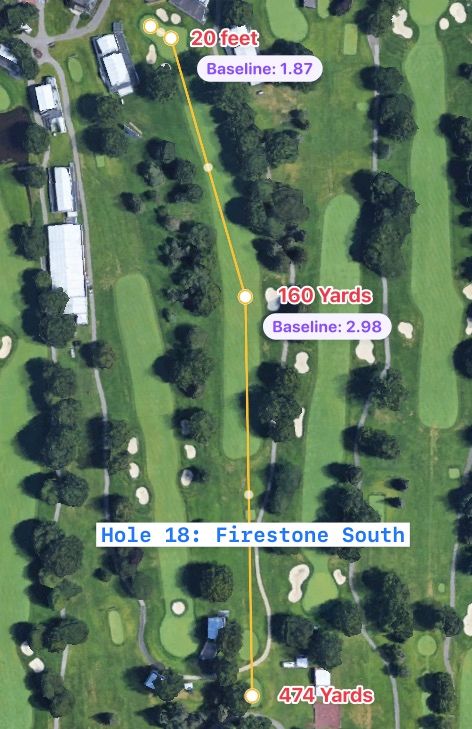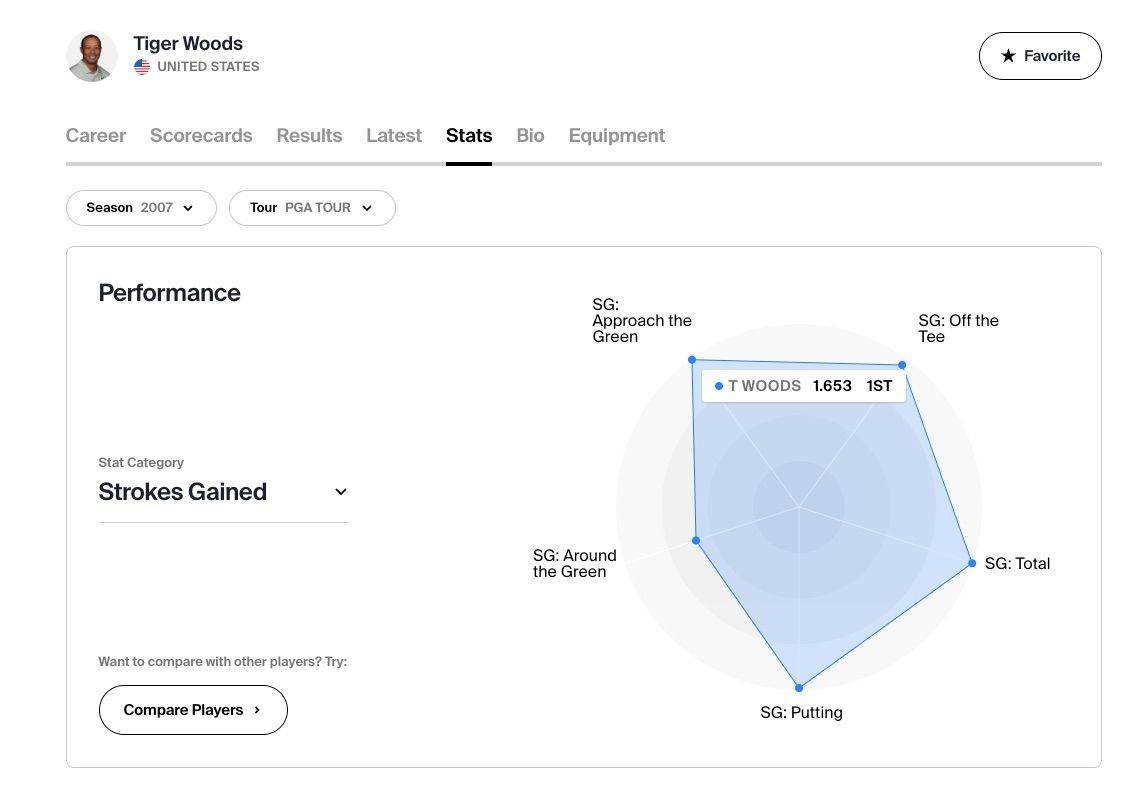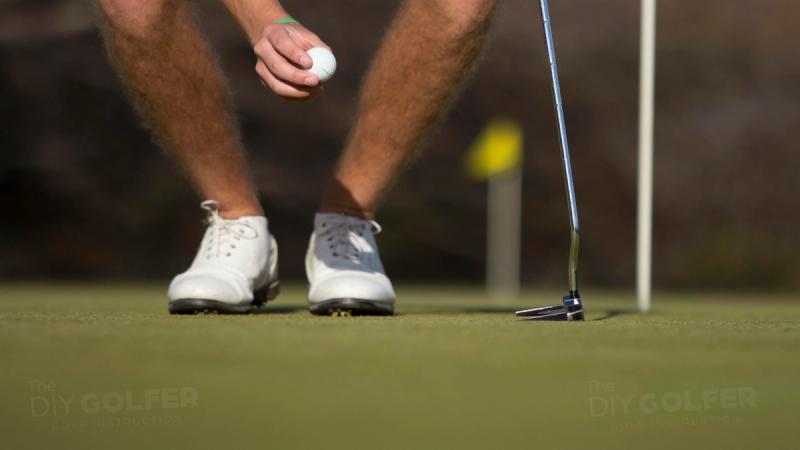Table of Contents

Last updated Jan 17, 2024
What is Strokes Gained Approach Shots? Explained
Strokes gained approach is an objective way to measure a golfer's ball-striking ability. In this post, I'll explain how it is calculated and why it matters.


What if I told you that the single biggest difference between you and a pro golfer is...
Your approach shots.
While it differs per golfer, many amateurs are surprised when I tell them that their long game is far more important than their short game when it comes to lowering their score.
In this post, I'm going to explain what "strokes gained approach" is all about and why it matters to your game.
TLDR;
This statistic tells us how good of a ball-striker a golfer is (e.g. irons).
What is measured?
Strokes gained approach represents all shots over 30 yards (from edge of green) that are NOT tee shots on par 4s or par 5s. This metric includes par 3 tee shots.
Calculation and Formula
The formula for strokes gained approach (SGA) is:
SGA = Avg. strokes to hole out (start) - Avg. Strokes to hole out (end) - 1
Where "Avg. Strokes" is a "benchmark" calculated from hundreds of thousands of golf shots from the tour's ShotLink system.
Can Amateurs use this stat?
Yes, I recommend Arccos for tracking your strokes gained statistics.
Strokes Gained Approach: Tiger's Secret Weapon
We can all agree that Tiger is one of, if not the greatest golfers of all time.
But can we agree on why?
Some would argue that Tiger's dominance came from his putting. Others claim that it came from driving... Or chipping...
Thanks to the strokes gained methodology and the work done by Mark Broadie in Every Shot Counts, we now have a fairly objective answer to this question—and it may surprise you.
Tiger's dominance primarily came from his approach shots.
There, I said it.
As a former competitive golfer myself, I tend to think that his dominance came from his mental game, but we can't quantify that. We can quantify how much different parts of his game contributed to his victories by using strokes gained data.
Mark Broadie's research shows that over his career, Tiger gained ~1.28 strokes per round on his competitors.
That is... INSANE.
Tiger hits 75% of greens from 150-200 yards vs. the tour average of ~67%. Talk about an advantage.
But we're not here to talk about Tiger. We're here to talk about YOUR GAME.
Why should an amateur golfer care?
"But Zach, I'm not Tiger! I need to improve my driving and putting, not my iron shots!"
And you may be right.
But when it comes to golf improvement, the most important thing is to start tracking statistics and get an objective view of where your game needs work.
You can start by tracking your total greens in regulation, but that statistic doesn't tell you everything. If you're playing a course with massive greens, this statistic will be inflated even if you don't strike the ball well.
Strokes gained approach is all about proximity to the hole, which gives you an objective view of how well you struck the ball during a round, tournament, or entire career!
With strokes gained approach data, you can answer questions like:
- How well do I strike it from 100-150 yards?
- How well do I strike it from 150-200 yards?
By answering these questions, you'll know what to practice in your limited time at the range.
Furthermore, if we connect the dots between approach shots and strokes gained putting, we know that getting the ball a few feet closer to the hole can drastically improve your chances of making a putt.
What's wrong with the GIR (greens in regulation) statistic?
Greens in regulation, or "GIR" is a traditional golf statistic that measures how many greens a golfer hits "in regulation" during a round. If a golfer is playing a par 4 and hit the ball on the green in 2 strokes, that is a "green in regulation".
The PGA Tour average for this statistic is generally around 67%, while most amateurs hit less than 50% of greens.
This statistic is great for a simple measure of ball striking performance of a golfer, but has limitations:
- It doesn't account for the length of the course
- It doesn't account for the size of the greens
- It doesn't account for the weather conditions
That's why strokes gained approach is a much more objective and overall better method of assessing the overall ball striking of a golfer.
What is Strokes Gained Approach?

Formally, the strokes gained approach measures all shots over 30 yards (from the edge of the green) except tee shots on par 4 and par 5 holes. This includes par 3 tee shots.
Strokes gained approach is one of several strokes gained statistics tracked by the ShotLink system on Tour. You can find the official statistics on the PGA Tour website. Amateur golfers can track this through systems like Arccos as I'll explain later in this post.
In the screenshot above, you can see that during the 2023 season, Scottie Sheffler led the tour in strokes gained approach. On average, Scottie gained 1.194 strokes on the field per round, and during the 2023 season, gained 88.344 strokes on the field over all his rounds.
While the official stat measures strokes gained approach by round, we can measure it in many different ways. Given the right data, we could measure strokes gained approach:
- For a single golf hole
- For a round of golf
- For a full golf tournament
- For an entire golf career
- Between two golf courses
- Between two golf tournaments
In other words, we could say that Rory Mcilroy "gained 2.2 strokes on the field during the Players Championship".
We could also say, "Over his career, Rory Mcilroy has lost 0.2 strokes against his peers on approach shots"
Or even, "Pebble Beach's greens are 0.3 strokes harder to hit than Bethpage Black's greens" (because they are so small).
I know, I know, this is confusing! Let's take a look at some examples to better understand the elusive strokes gained approach metric.
How is Strokes Gained Approach Calculated?
Calculating strokes gained approach is simpler than you think! At its core, this metric revolves around comparing a player's approach shot performance to a benchmark, typically derived from data collected on professional tours like the PGA Tour. It's a great way to objectively assess ball striking ability of a golfer.
Strokes Gained Approach Formula
The basic formula for strokes gained approach is:
SGA = Avg. strokes to hole out (start) - Avg. Strokes to hole out (end) - 1
For example, let's say a player hits their ball in the fairway and has 140 yards left. From 140 yards in the fairway, a PGA pro will on average take ~2.91 strokes to hole out.
Next, let's say this player hits the green and has 10 feet left to the hole. Based on historical data, we expect a tour pro to take ~1.61 strokes from this distance to hole out.
So our formula is:
SGA = 2.91 - 1.61 - 1 = 0.3
In this example where a player hits a 140-yard approach shot from the fairway to 10 feet on the green, they have gained 0.3 strokes on the field.
We also must subtract 1 at the end to account for the stroke taken.
As you can see, SGA is a function of location (fairway, rough, sand, etc.) and proximity (how close the ball ended to hole).
Let's walk through the in-depth methodology here.
Basic Calculation Methodology
As with other strokes gained statistics, strokes gained approach is tracked using the following basic methodology:
- Establish a Baseline: The baseline is the average number of strokes a player takes to hole out from a given location and distance. For example, if a golfer is 135 yards from the rough, the baseline might be ~3.1 strokes. If an amateur is calculating strokes gained, they will typically compare to players of similar handicaps (skill levels) through an ecosystem like Arccos.
- Compare Individual Performance: Next, we compare a player's performance to this baseline. If a golfer hits a 150 yard shot to 3 feet, they will gain strokes against the field.
- Aggregate Data Over Rounds: This process is repeated for every shot in a round, and the values are aggregated. Positive values indicate better-than-average ball striking, while negative values suggest there's room for improvement.
Step 1: Establish a baseline
For our baseline, we'll look at a small sample of PGA Tour benchmarks. These numbers are not exactly what is used on tour (those numbers are constantly being updated), but are very close as they were sampled from Mark Broadie's book, Every Shot Counts:
| Distance | Tee | Fairway | Rough | Sand | Recovery | Green |
|---|---|---|---|---|---|---|
| 3 ft | n/a | n/a | n/a | n/a | n/a | 1.04 |
| 5 ft | n/a | n/a | n/a | n/a | n/a | 1.23 |
| 10 ft | n/a | n/a | n/a | n/a | n/a | 1.61 |
| 20 ft | n/a | n/a | n/a | n/a | n/a | 1.87 |
| 20 yds | n/a | 2.4 | 2.59 | 2.53 | n/a | n/a |
| 80 yds | n/a | 2.75 | 2.96 | 3.24 | n/a | n/a |
| 100 yds | 2.92 | 2.80 | 3.02 | 3.23 | 3.80 | n/a |
| 160 yds | 2.99 | 2.85 | 3.08 | 3.21 | 3.78 | n/a |
| 180 yds | 3.05 | 3.08 | 3.31 | 3.4 | 3.82 | n/a |
| 200 yds | 3.12 | 3.19 | 3.42 | 3.55 | 3.87 | n/a |
Rows 1-4 are for putting, 5-6 are for "around the green", and the remainder are for approach shots.
Again, this is just a small sample to use for our examples. To calculate official statistics, more data points are used.
Step 2: Compare Individual Performance
For this example, let's say Tiger Woods is playing the 18th hole at Firestone South course during the WGC Bridgestone Invitational:

Let me start with an important note—we're ONLY looking at strokes gained approach here. Remember, strokes gained putting and strokes gained off the tee are separate metrics.
Strokes gained approach are shots over 100 yards that are not tee shots on par 4s and par 5s.
Therefore, the tee shot here and the putts will NOT go into our calculation.
On this hole, Tiger hit his drive in the fairway and had 160 yards left. He then hit it to 20 feet on the green. To calculate SGA, we have to figure out how many strokes are expected from the middle of the fairway at 160 yards (from the table above, that is 2.98 strokes). Then, we have to figure out how many strokes are expected from 20 feet on the putting green (from the table above, that is 1.87 strokes). We now subtract the two and take away 1 for the stroke taken.
SGA = 2.98 - 1.87 - 1 = 0.11
In this scenario, by hitting it to 20 feet from this distance, Tiger gained 0.11 strokes on the field.
Step 3: Aggregate
Now that you understand the individual calculation, we just need to go through this process for every hole during this round and sum them all up to get the official strokes gained approach metric that the PGA Tour tracks.
Finally, we can average it for all rounds of a season to get an annual metric. Below, you can see Tiger's strokes gained stats for 2007. He led the tour in strokes gained approach shots and on average, gained 1.65 strokes per round on the field!

"Median Leave": A better way to evaluate ball striking?
In his book, Every Shot Counts, Mark Broadie outlines an alternate way to measure approach shots called "median leave". While this is closely related to the strokes gained approach stat, it provides us with a slightly different angle. For example, take a sample from Broadie's analysis (2004-2012):
| Rank | Golfer | SGA | 100-150 yds | 150-200 yds | 200-250 yds |
|---|---|---|---|---|---|
| 1 | Tiger Woods | 1.28 | 4.9% | 5.2% | 6.2% |
| 2 | Robert Allenby | 0.88 | 5.2% | 5.5% | 6.4% |
| 3 | Jim Furyk | 0.78 | 5.1% | 5.4% | 6.6% |
| ... | |||||
| 12 | Scott Verplank | 0.60 | 4.6% | 5.3% | 7.1% |
When we talk about median leave, we're referring to the percentage of total distance left after an approach shot.
Median Leave = Distance Remaining / Distance Starting
In other words, if a golfer hits a shot from 200 yards to 30 feet, that's a 5% "leave":
Median Leave = 30ft / 600ft = 5%
And yes, 600 feet is equivalent to 200 yards (we need similar units to calculate this).
By looking at median leave, we can better assess how well a golfer performs from different distances. For example, in the sample table above, you can see that during this time period, Scott Verplank was actually the best ball striker from 100-150 yards, but performed poorly from longer distances compared to other top players.
Can Amateur Golfers Use Strokes Gained Approach?
At the time of writing, the golf industry has come a long way with consumer-grade technology. With the proliferation of shot trackers and personal launch monitors, it has become easier for amateur golfers to assess their games with real on-course data.
That said, tracking strokes gained approach statistics still proves difficult for many golfers.
Why?
Because as we talked about earlier, strokes gained calculations require benchmark data.
This means that for a 15-handicap golfer to assess their game with strokes gained approach data, all of the following things must be tracked:
- Every approach shot must be tracked (location AND distance)
- Thousands of golfers who play to a 15 handicap must also track their approach shots
- All this data must be aggregated in one spot (ecosystem)
For the PGA Tour, this is easy. ShotLink tracks every golf shot from every tournament for every tour pro automatically.
For us amateurs, we don't have this luxury (and frankly, most of us probably don't want all of our shots tracked!)
There are a few options though and I'm excited to see how this evolves in the next decade!
Option #1: Automatic Tracking
In my opinion, automatic strokes gained tracking is the best option. Tracking every shot for every round you play is exhausting and most golfers do not have the discipline to keep this up over a long enough period for it to start helping their games.
At the time of writing, here are a few shot trackers that also have strokes gained statistics built-in to their ecosystems:
- Arccos Shot Trackers: The Arccos system has strokes gained calculations available to users (via the app) and thanks to all the amateur data they have collected, you can compare your rounds against golfers of similar skill levels. This is a huge benefit and allows for the most accurate strokes gained data.
- ShotScope Trackers: A close second to Arccos, ShotScope offers shot trackers and an app that calculates strokes gained data. From what I've seen, ShotScope does not have quite as many data points as Arccos, but is a great alternative.
Option #2: Manual tracking
Several apps allow you to track all of your shots manually and then review strokes gained data within the dashboard. While this can be cumbersome and exhausting to some golfers, it is a great option if you are highly disciplined and dedicated to improving your golf game.
Here are a few to check out:
- My Round Pro
- PinPoint Golf
- Decade Golf: This is more of a system than an app. While it does have an app, this is a premium service you pay for to help learn better golf strategy based on strokes gained data.
Other Types of Strokes Gained Statistics
At this point, you might be thinking—"Zach, we've talked a lot about approach shots, but what about the rest of my game?"
And you would be correct.
Strokes gained is more than just approach shots. It is an entire framework for measuring relative golf performance in all areas of a golfer's game:
- Strokes gained approach (this article)
- Strokes gained around the green
- Strokes gained putting
- Strokes gained off the tee (driving)
Concluding Thoughts: Big Takeaways
If we dive deeper into strokes gained approach data, there are a few conclusions that may surprise you:
- In almost all cases, getting as close to the hole as possible is beneficial to your score (yes, partial wedge shots still yield better results than full wedge shots for most players)
- Hitting from the fairway is nearly always better for your score (even though the rough seems easier to hit out of for some players)
Remember these things and be sure to check out my other strokes gained posts!






